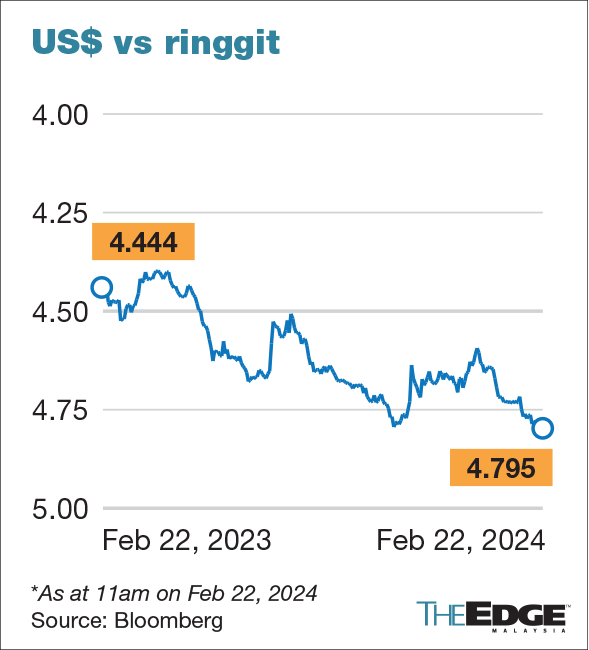
Photo by Shahrill Basri/The Edge
KUALA LUMPUR (Feb 22): MIDF Research said that fundamentally, the ringgit is in a good position to strengthen in 2024, as the domestic economy stays on upbeat momentum, supportive global commodity prices, a sustained trade surplus and possible central bank rate cuts globally in 2024.
In a thematic report on Thursday, the research house projected for the US dollar-to-ringgit exchange rate to average lower at 4.38 in 2024 (2023 average: 4.56), and reach 4.20 by year end (end-2023: 4.59).
With Malaysia as a net commodity exporter of crude petroleum, liquefied natural gas and palm oil, MIDF said the local note stands to gain from the supportive global commodity prices and sustained trade surplus.
It said that most importantly, the US Federal Reserve and other major central banks are done with their interest rate hikes, and will most likely turn to rate cuts in 2024.
"We expect the ringgit to appreciate, benefiting from more inflows coming back to the emerging markets," the research house said.
MIDF said the difference between Malaysia’s overnight policy rate and the US federal funds rate is among key factors influencing the trajectory of the currency pair.
“However, it is not the sole factor.
“Other factors that we believe has an influence on the ringgit are: i) the balance of payment; ii) foreign fund flows; iii) external trade; iv) foreign exchange policy; and v) commodity prices, among others,” it said.
MIDF said Malaysia’s current account surplus-to-gross domestic product ratio fell to 1.7% in 2023, the lowest since 1997.
“The ratio has been in single digits since 2012 and below 5% after 2013.
“Portfolio investment stayed in deficit since 2013 except in 2021.
“Stronger influence from other factors recently saw a breakdown in correlation between commodity prices and the ringgit,” it said.
Exchange rate influenced by multitude of factors
MIDF surmised that the performance of the US dollar-ringgit pair is influenced by a multitude of factors.
It said these factors can work in tandem, which would exacerbate the movement of the exchange rate, or it can be, at points, divergent of each other, which would moderate the ringgit’s movement.
“It is difficult to pinpoint the level of influence each factor has, as it depends on the current situation, be it external or domestic,” it said.
- FMM: Delay proposed 30% port tariff hikes
- MH370: 11 years on, is closure finally within reach?
- Petros wants strategic partnership with Petronas, says Fadillah
- Police probe video of former MP allegedly defaming PM, home minister
- Gobind: Malaysia needs to develop homegrown AI champions within semiconductor industry
- Trump team is pivoting to no pain, no gain as economic message
- MM2H programme open to applicants from any country, not just Chinese nationals — Tiong
- DBS digital banking, ATM services are disrupted for hours
- ECB’s Schnabel signals inflation concern in rate debate salvo
- Charting the global economy: US tariff launch proves messy; ECB cuts rates

